 |
 |
 |
| |
CD4 and Undetectable Viral Load Predict Non-AIDS Cancers: "AIDS and non-AIDS defining malignancies in HIV-infected patients -
The 2006 ONCOVIH French study"
|
| |
| |
Reported by Jules Levin
Lipodystrophy Workshop London UK Nov 6-8 2008
NOTE from Jules: This study found undetectable HIV viral load and higher CD4 counts helped to prevent non-AIDS malignancies. Other studies presented at CROI found CD4 and viral load associated with developing non-AIDS diseases and cancers, as well as of course HIV-associated diseases and cancers. Clearly, achieving higher CD4 counts and keeping viral load undetectable appears crucial to prevention of AIDS and non-AIDS death and comorbidities. This suggests that starting HAART earlier might be more effective at preventing diseases. However, at this Lipo Workshop a presentation by Reeds and I think also the presentation by Behrens suggests that HAART negatively affects the autonomic nervous system, but the clinical affect found in the French malignancies study might be, and I think it would, more important than delaying HAART. Perhaps more crucial to the decision to start HAART earlier are the questions of the readiness of the patients, and their adherence since developing drug resistance due to non-adherence is very important. Although developing lipoatrophy is also a very important risk associated with HAART, the rates of lipoatrophy are much lower than previously. Still, recent studies suggest there still are risks, but much lower.
Lanoy E1, Spano JP2, Bonnet F3,4, Boue F5, Cadranel J6, Carcelain G7, Couderc LJ8 Frange P9, Girard PM10, Oksenhendler E11, Poizot-Martin I12, Semaille C13
Agut H14, Katlama C1,15, Costagliola D1,15 and the ONCOVIH study group
1. INSERM, U720; UPMC Univ Paris 06, Paris
2. AP-HP, Groupe hospitalier Pitie-Salpetriere, Paris
3. CHU de Bordeaux, Hopital Saint-Andre, Bordeaux
4. INSERM, U897, Bordeaux
5. AP-HP, Hopital Antoine Beclere, Clamart
6. AP-HP, Hopital Tenon, Service de Pneumologie et Reanimation, Paris
7. AP-HP, Groupe hospitalier Pitie-Salpetriere, Service d'Immunologie, Paris
Hopital Foch, Service de Pneumologie, Suresnes
9. AP-HP, Hopital Necker-Enfants Malades, Service d'Immunologie et Hematologie Pediatrique, Paris
10. AP-HP, Hopital Saint-Antoine, Service des Maladies Infectieuses et Tropicales, Paris
11. AP-HP, Hopital Saint-Louis, Service d'Immunologie Clinique, Paris
12. CISIH, Hopital Sainte-Marguerite, Marseille
13. Institut de Veille Sanitaire, Saint Maurice
14. AP-HP, Groupe Hospitalier Pitie-Salpetriere, Laboratoire de Virologie, Paris
AP-HP, Groupe hospitalier Pitie-Salpetriere , Paris
AUTHOR SUMMARY - CONCLUSION
In 2006, in France, almost two third of malignancies reported in the ONCOVIH study were non AIDS defining malignancies. Apart for lung cancer, all frequent malignancies in HIV-infected patients are associated with viruses (EBV, HHV8, HPV, HBV, HCV,É)
Malignancies were diagnosed in patients aged of 47 years with a lower CD4 cell count than those observed in all HIV-infected patients followed in hospital
Patients diagnosed with AIDS defining malignancy had more frequently a plasma HIV-RNA > 500 cps/mL
These results suggest that prevention of malignancies requires a better control of HIV replication and its associated immunodeficiency in addition to the prevention of other risk factors, such as smoking
Perspective: to describe the management of malignancies in HIV infected patients and to evaluate the prognosis after the diagnosis of the different types of malignancy
OBJECTIVES
To describe the distribution of malignancies in HIV-infected patients
To describe the one year survival of these patients in France
To describe main characteristics for malignancies in HIV-infected patients
Criteria for eligibility
HIV-infected adults or children
Patients diagnosed with a new malignancy, in France, in 2006, confirmed by histology (except for primary brain lymphoma*), including AIDS defining malignancies (non Hodgkin Lymphoma (NHL), Kaposi sarcoma, cervix cancer)
Patients with malignancy diagnosed after death
* Primary brain lymphoma was defined as cerebral tumor with neither clinical nor radiological response after a 15 days Ð antitoxoplasmosis therapy
Collection of the data
Centers involved in management of HIV-infected patients and/or of patients with malignancy were approached
349 centers agreed to participate to the ONCOVIH and to report all new cases of malignancies
Characteristics of HIV infection, malignancies were collected at the diagnosis
Histological results and causes of death were reviewed by the ONCOVIH panel of investigators including clinicians and epidemiologists to validate the cases and define the cause of death
HIV-infected patients followed in France
The French Hospital Database on HIV infection (FHDH ANRS CO4) collects clinical, biological and therapeutic data on HIV infected patients followed in 62 hospitals in France, including overseas departments
Almost 50,000 patients are typically followed in the FHDH ANRS CO4 in a given year, for an estimated 88,000 infected patients in care in France
To compare characteristics of patients diagnosed with a malignancy with those of HIV infected patients, data from HIV patients enrolled in the FHDH ANRS CO4 were extracted
Reporting of the malignancies
Overall, in 2006, 694 new malignancies were reported
282 centers of the 349 participating in the study were managing the patients with the reported malignancies
Characteristics of the HIV-infection and of the malignancy at diagnosis were available in 669 patients (673 malignancies
Frequency of malignancies according to the gender
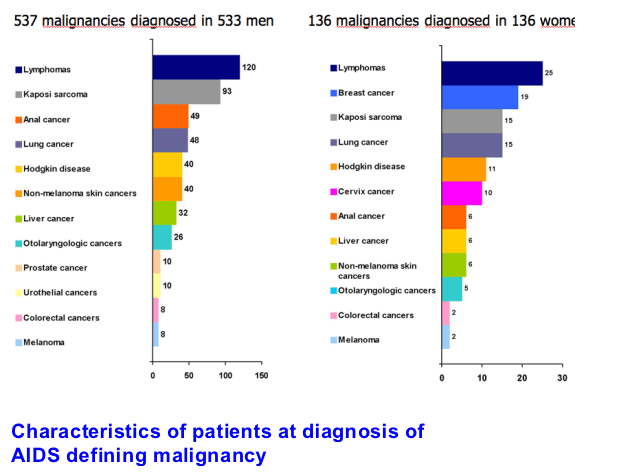
From Jules: you'll notice median CD4 counts are lower for patients developing all malignancies in this table compared to other patients in ANRS CO4 FHDH; and you'll notice that except for cervix cancer median CD4 nadir is lower for patients developing malignancies compared to other patients in ANRS CO4 FHDH. Also, percent of patients with undetectable HIV viral load was lower for patients developing malignancies compared to all patients in ANRS database (10-33% vs 67%).
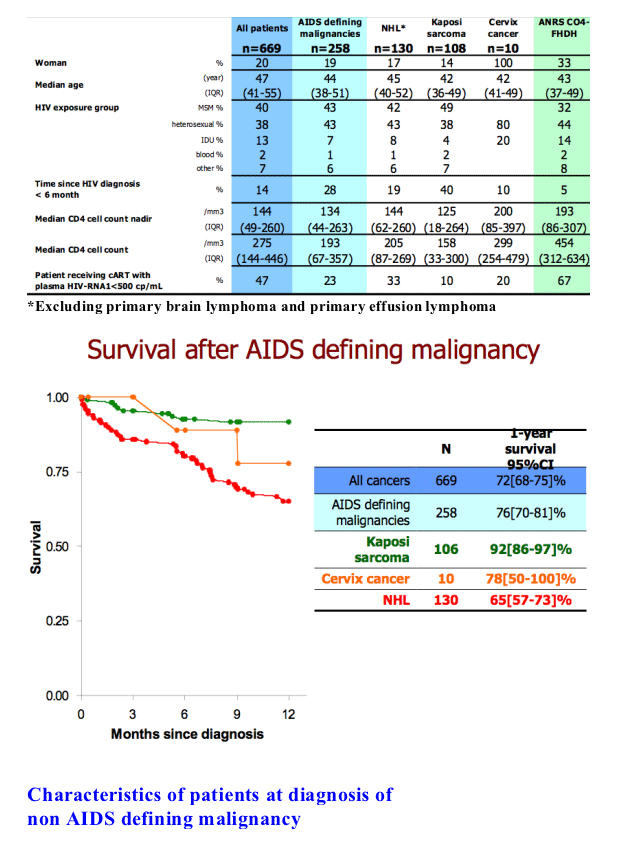
From Jules: You'll notice median CD4 counts at which patients develop non-AIDS malignancies although lower than for all patients in ANRS database are higher than median CD4 counts at which patients develop AIDS malignancies (256-381 vs 454). This suggests that it is important to have higher CD4 counts, 500 or higher to protect against non-AIDS malignancies.
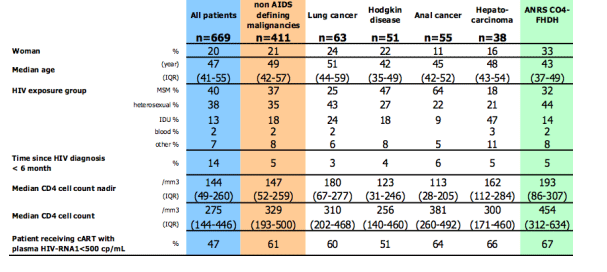
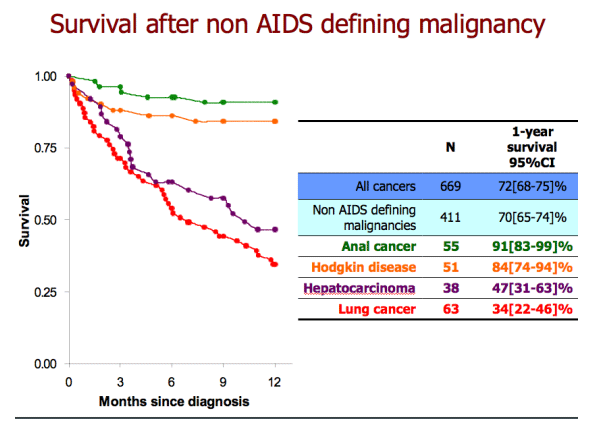
from Jules: of note, death rates are much higher from non-AIDS malignancies. Because we have been able to get HIV under control due to HAART AIDS-related causes of death are lower but now patients are dying from non-AIDS malignancies.
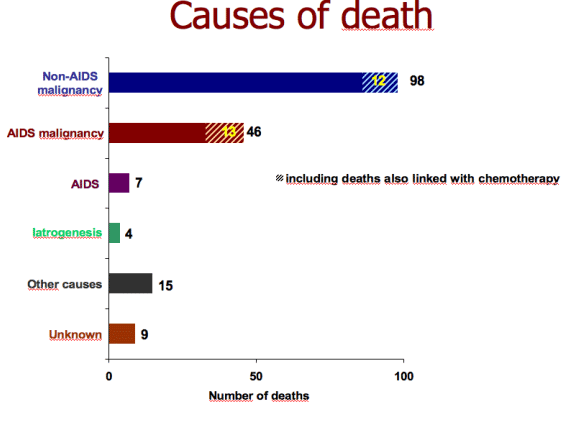
|
| |
|
 |
 |
|
|